Insect pests make their living by feeding off plant sap or nutrients. These insects live off both indoor and outside plants. One example of such an attacker is russet mites. These tiny pests give hard times to both farmers and houseplant enthusiasts.
What are Russet Mites?
Russet mites are the tiniest pests that give big problems to plants. They are members of the family eriophyid of mites. These guys are the hardest to detect among other plant infecting mites such as tomato and cannabis sucking. These are invisible to the naked eye and only visible when in clusters. Under 10X hand lenses, the adult russet mites appeared torpedo, semi-transparent, and wedge-shaped cylinders. In cluster form, they appear yellow-tinted.
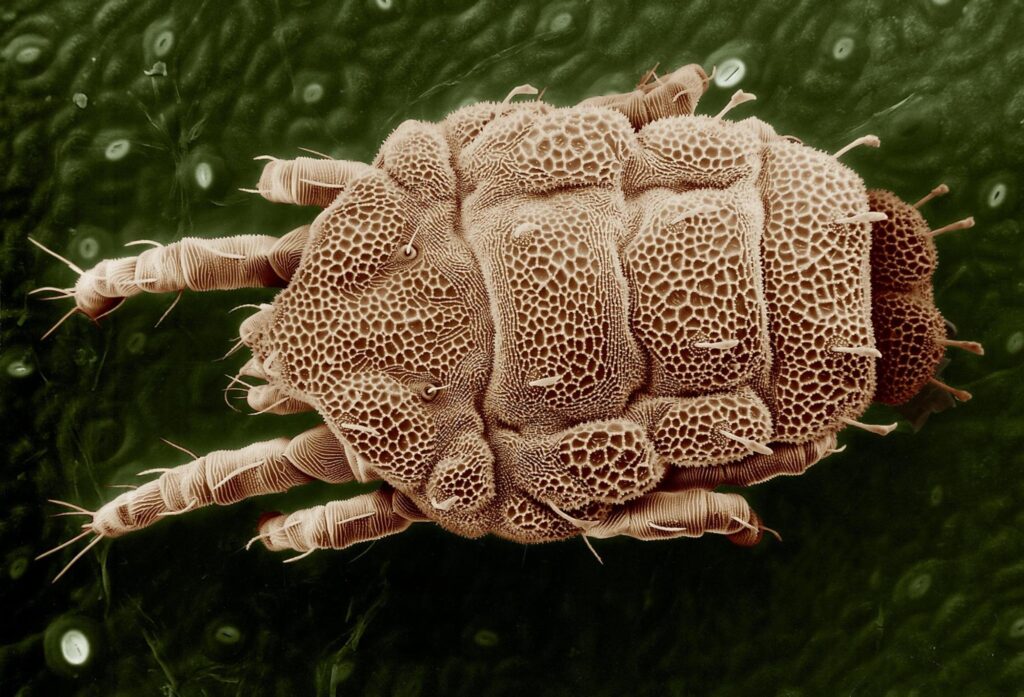
Identification of Russet Mites
Russet mites have piercing-sucking mouthparts. They suck sap from the epidermal cells of infested plants. Unlike spider mites, they do not have typical webbing formation on infested plants. Instead, they produce typical yellowing (chlorosis) and curling symptoms. The heavily infested houseplants appeared chlorotic. In addition to that, the leaves get downward curling. These tiny mites reproduce quickly and go unnoticed due to invisibility to the naked eye.
Chlorosis— the yellowing of leaves of infected plants due to chlorophyll degradation.
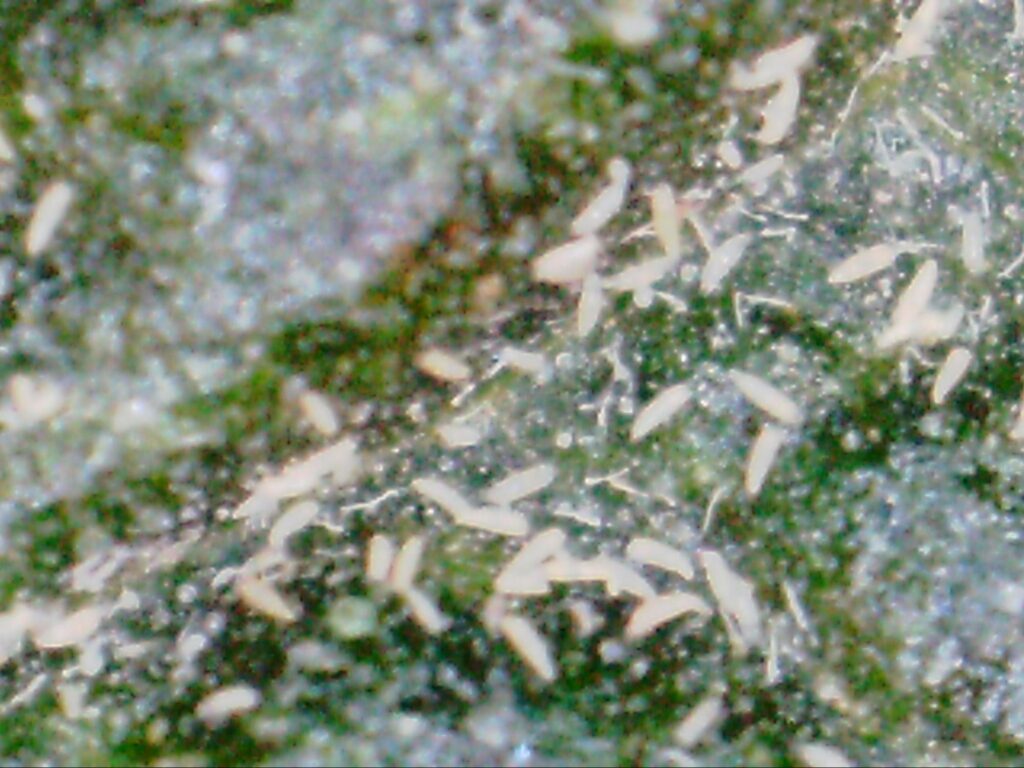
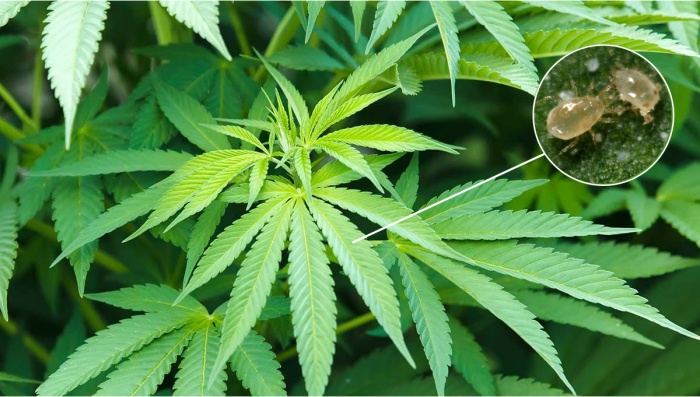
Due to higher reproducibility, these guys cause severe damage and are only spottable when symptoms appear.
Most often, the russet mites damage presents resemblance to nutritional disorders. First, the adult russet mites feed on the underside of leaves and suck nutrients from epidermal cells. Next, they start sucking sap from the stem, leading up to top leaves. Intensive feeding harms plant growth and causes stunting. Another significant symptom is stunted growth and wilting.
What are the Signs & Symptoms of Russet Mite Infestations on Houseplants?
Infested plants show greasy stems, which later on become bronzed. Russet mite also causes cracked in stems and petioles. These broken sections of plants become feeding sites for more populations. These tiny pests continue to eat on the branch until the damage appears in the form of stunted growth. Another vital sign of the russet mite infestation is the typical russeting of leaves. And leave becomes brittle and brown.

Life Cycle of Russet Mites
The life cycle of russet mites involves eggs, two larval nymphs, and an adult stage. The adult russet mites are 0.1-0.2 mm long. They lay eggs on the underside of leaves, stems, and petioles. The eggs appear transparent to white and round in shape.
Within two days, the eggs hatch, and small nymphs (minute larvae) appear; after a couple of days, they molt into larger larvae. The larger larvae transform into adults a few days later while undergoing the final molting. Both female and male adults produced.
The entire life cycle of these microscopic mites completes within two weeks with optimum weather conditions. During each life cycle, the females lay almost two dozen of eggs. Russet mite eggs are flat, while the hemp russet mite eggs are round. Hemp russet mite or russet mite eggs are transparent or pale and yellow.
Both males and females live almost three weeks and exist throughout the seasons. They do not possess any dormant stages (such as the egg dormancy stage). During winters, they stop reproduction and undergo semi-dormant conditions.
The adult mites crawl very short distances and can only crawl to the upper side of leaves. In outdoors, their presence on leaves helps in dispersing neighboring plants and long distances. Wind and slight air breeze spread russet mites. On the other hand, immature nymphs remain immobile.
What are the Host Plants of Russet Mites?
These microscopic insects are present all year round on various host plants. The voracious pests cause severe damage to both indoor and outside plants. The hosts of russet mites include cannabis, eggplants, tomatoes, potatoes, and tomatillo. Their source of infestation is solanaceous plants. In warm and dry weather, such as from April-June, they reproduce uncontrollably. And cease the vigorous green growth of their host plants.
How to Get Rid of Russet Mites?
Once they contact their host plants, these insects reproduce uncontrollably because their smaller size goes unnoticed. Therefore, to effectively manage the infestations of mites on both indoor and outside plants is to employ the integrated pest management approach. In addition to that, the prevention from russet mites or hemp russet mites serves as the best protection method.
Following are the best methods or approaches that control the infestations of wedge-shaped mites.
Monitoring for Russet Mites
Both indoor and outside plants should constantly be monitored for the presence of any russet mites. And if any noticed should be removed quickly by spraying. Also, due to their smallest size, a hand lens of 10- 14X pixels to keep an eye on mites.
Cultural Practices for the Management of Russet Mites
- To avoid the infestations of russet mites on indoor and outside plants, remove dead and infected plant parts.
- If there are any signs and symptoms of a plant infected with russet mites, remove in case of outside plants and quarantine in houseplants.
- The hot and dry weather favors the growth and reproduction of russet mites. And by avoiding the plant during summer, their infestations can be controlled.
- The movement of people from infected to healthy places should be restricted.
- The places around indoor should be kept clean. Any dead or symptomatic leaves should be cleaned rapidly.
- In the case of indoor plants, the plant material should be resistant or disease-free.
- While purchasing the houseplants, the entire plants are constantly checked for any type (yellowing, drying, and curling of leaves) of russet mite symptoms.
- Once the plants are in the house, the proper phytosanitary conditions should be maintained.
Chemical Control of Russet Mites
For chemical control of russet mite, miticides effectively kill these small enemies. Following are the chemicals used to eradicate mites on houseplants.
Sulfur dust or spray on houseplants can wash off the tiny nymphs from infested plants. For example use of wettable sulfur effectively eliminate the russet mites. This elemental sulfur effectively manages the mites and kills the fungus infections in houseplants. Wettable sulfur comes in a fine yellow powder that dissolves in water for spraying.
How to Effectively Make the Spray of Wettable Sulfur to Get Rid of Mites?
…Use 2-3g of wettable sulfur per liter of water for each spray. This spray can also be used to control red spider mites. While for blister mites, use 2.5-5g of sulfur powder per liter of water. This concentration also effectively controls grape leaf rust mite. The sulfur spray should be uniformly applied to plants, including stems, petioles, and the underside of leaves.
For every application, shake the spray bottle vigorously. For example, 2-3 applications of sulfur spray with a two-week interval provide effective prevention against mites in houseplants.
Azera Gardening
This organic insecticide is a broad-spectrum chemical that effectively controls almost all common pests of indoor and outdoor plants. Apply Azera solutions in dilutions as soon as possible when the first insect infestation appears.
Under high pest populations, apply high rates of Azera. Do not spray the plants to the point of runoff and dip—Spray Azera solutions after one-day intervals.
Molt-X Azadirachtin
Molt-X is derived from the neem tree and kills mite insects. This organic insecticide has various modes of action. It inhibits insects’ growth, reproduction ability and acts as a repellant. It also disrupts the mites molting process. For indoors, the uniform spray of Molt-X should be applied. Or in the group of plants, one gallon for 500 feet square.
AzaGuard
It acts as a repellant and is widely used as an insecticide to kill insects of indoor plants. It also manages russet mite infestations by disrupting their lifecycle, growth, and reproduction. For indoor plants, use 8-16 fl. oz per 100 gallons to prevent the infestation of russet mite infestations or hemp russet mite.
PureCrop 1
PureCrop 1 is an organic fungicide and insecticide that is derived from plants. This insect killer controls sap-sucking insects such as russet mites for indoor plants. The mode of action of PureCrop 1 involves the disruption of the food digestion process of insects. It also dissolves the body membranes of insect pests.
PureCrop 1 improves plant health as well. It helps plant nutrient uptake and improves plant root development, foliage health, and flowering.
Biological Control of Russet Mites
Predatory mites (Amblysieus andersoni)
The predatory mite (Amblysieus andersoni) feeds on russet mite or hemp russet mite. Amblysieus andersoni controls all stages of phytophagous russet mites in indoor plants. Therefore, it is the best choice to eliminate the pre-emergence of russet mites on both indoor and outdoor plants. These mites best perform at 42-100℉, >50% relative humidity.
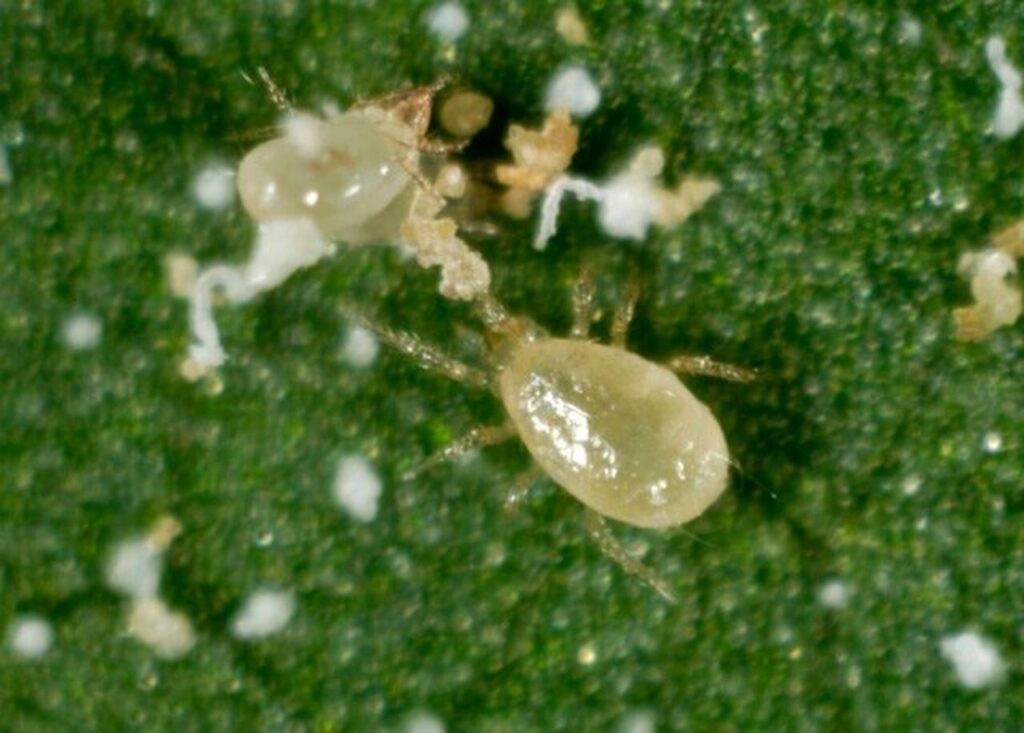
Neoseiulus californicus
These tiny mites prey on russet mites and prevent further spread in plants. However, they are slow feeders, and in conjunction with other beneficial mites, they can increase the feast on russet mites.
Their favorable environmental conditions are 50-105℉ and 40-60 % relative humidity. Apply 1-4 of Neoseiulus californicus on houseplants and 5,000 to 20,000 per acre of outdoor crops.
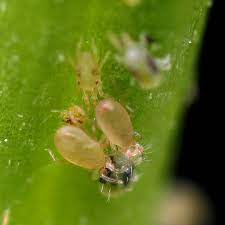
Related: Russet Mites vs. Spider Mites: Their Differences and Management For Plant Good
Amblyseius swirskii
This predatory mite (Amblyseius swirskii) is beneficial for russet mite or hemp russet mite control during the warmer season. It also feeds on thrips, whiteflies, and aphids. The optimum condition for the Amblyseius swirskii is 77-85℉ and relative humidity of approximately 70%. This killer mite is also effective in controlling hemp russet mite on the hemp plant.
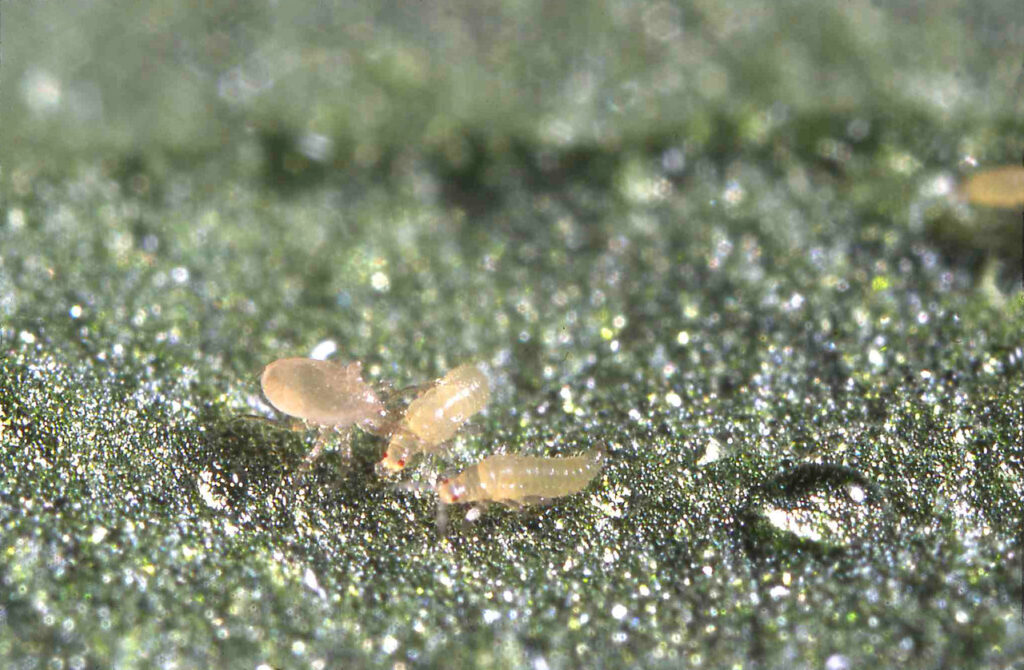
Amblyseius cucumeris
These tiny mites vastly feed on thrips but also prey on a wide range of mites. The ideal condition is 68°-77°F, 65-70% relative humidity. Apply 10-20 mites per square ft. or 100-400 per square meter.

Use of Oils for the Management of Russet Mites
Monterey Horticultural Oil
It contains mineral oil that functions as an insecticide, fungicide, and miticide. Apply this oil with water dilutions to control infestations of this tiny mite on houseplants.
Organic JMS Stylet oil
It is derived from neem plants. The organic JMS stylet oil spray on affected plants prevents the infection of microbes and hemp russet mite. It impairs the insect’s respiration process and kills the mites. It works best at 60-70℉ with repeated applications.
For every one gallon of Organic JMS Stylet oil per 100 gallons of emulsions are used to spray on houseplants. Shake the bottle every time before use for best results.
SuffOil-X Miticide
This oil emulsion kills both microbes and pests of houseplants. It suffocates the insect pests and inhibits their growth. In infectious microbes, it restricts spore germination. Its applications, along with predatory mites, prove great results. Apply 1-2 gallons of SuffOil-X miticide per 100 gallons of water for houseplants. This organic oil also eliminates broad mites on the hemp plant.
FAQs
What are the Best Approaches in Controlling Russet Mites or Hemp Russet Mite?
The best-suited methods for managing these tiny enemies are the application of wettable sulfur and biocontrol agents. For houseplants, the mild applications of wettable sulfur with every two-week interval eliminate this enemy or hemp russet mite. For outdoors, biological control serves the eco-friendly goals.
What damage Do these hemp russet mites or tiny enemies of houseplants?
These tiny enemies of plants stunt their growth and deform the leaves. The russet mite damage also involves the distorted stem of indoor plants as the eriophyoid mites have sucking mouthparts. And they suck sap through their stylet. So russet mite damage deprives houseplants of their nutrients. They also affect the bud growth of host plants.
Can Russet Mite Survive Winter?
Some mite species survive winter, and some do not because most mite species prefer warm temperatures. While hemp russet mites live all year round on cannabis plants when grown indoors. At the same time, other mite species stop their reproduction in winter.
Does Neem Oil Works on Russet Mite?
The neem oil serves the best organic approach in controlling these enemies. These oil applications kill mites and repel them. And its applications should be carried out when the first sign of damage appears.
What Does Sulfur Do to Russet Mite?
Sulfur falls in the chemical control category, and it rapidly kills the russet mite. Sulfer is a fine yellow powder applied in dilutions with water. It also works as a fungicide, insecticide, and miticide. It kills the mites through contact or when they ingest it. It is effective in rapid control of russet mite. The sulfur spray also effectively kill mites on cannabis plants and tomato. These eriophyoid mites can be controlled through sulfur applications with biocontrol agents for industrial hemp productions
Sources for Further Reading
- Pulkoski, M., & Burrack, H. (n.d.). Hemp russet mite in industrial hemp. NC State Extension Publications. Retrieved December 21, 2021, from https://content.ces.ncsu.edu/hemp-russet-mite-in-industrial-hemp
- https://www.planetnatural.com/pest-problem-solver/houseplant-pests/russet-mite-control/
- https://www.trifectanatural.com/problem-identifier/how-to-get-rid-of-russet-mites/
Check out What are the Best Practices to Get Rid of Thrips on Houseplants?
Find out about What are the Effective Ways to Fix Nitrogen Toxicity in Houseplants? and What Are Mealybugs? How to Kill Them on Succulent Plants?







